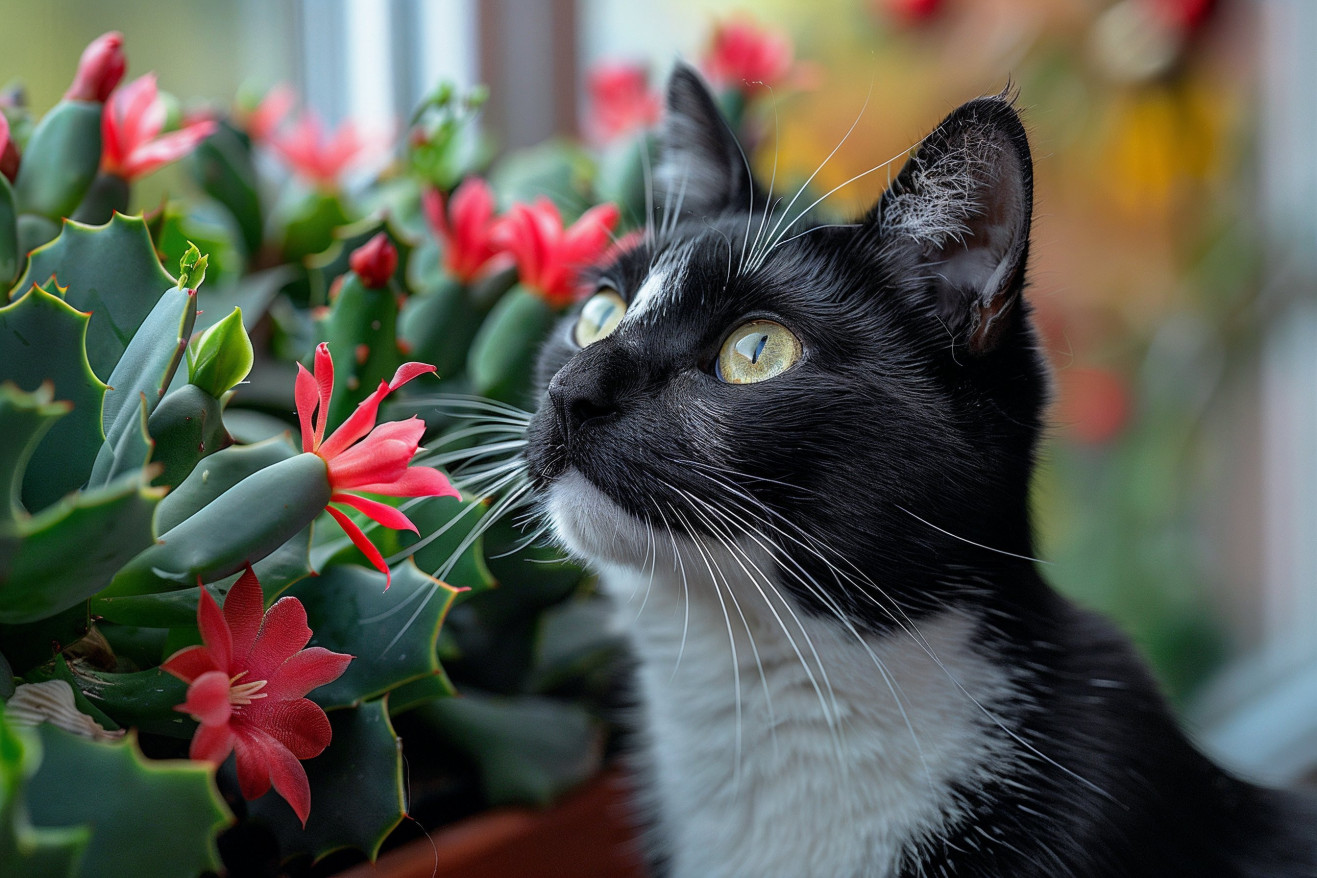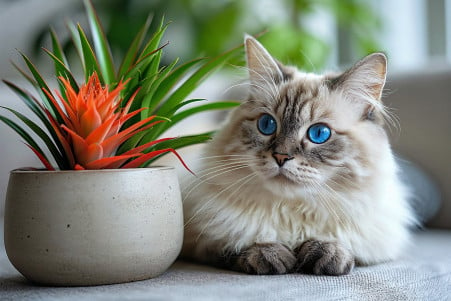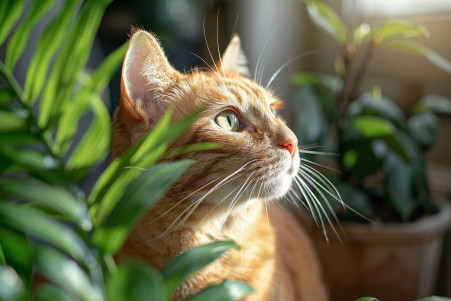Can Cats Eat Christmas Cactus? A Safe Holiday Guide
10 March 2024 • Updated 10 March 2024

As you start to deck the halls, you may be wondering if the Christmas cactus you’re bringing into your home is safe for your cat. Christmas cactus is generally safe for cats. That said, if your cat does eat the plant, it may cause some mild gastrointestinal issues, such as vomiting or diarrhea. It’s best to keep the plant in a place that your cat can’t reach to avoid any tummy troubles.
To help you feel confident in your ability to keep your cat safe, we’ve done the research for you, combining information from botanical and veterinary research and referencing trusted pet health publications.
In this article, we’ll cover what Christmas cactus is and why it’s safe for cats, as well as potential dangers and symptoms to look out for if your cat decides to take a bite out of this popular holiday plant. This all-encompassing guide will give you the information you need to make sure your cat stays safe this holiday season.
Is Christmas cactus safe for cats?
Christmas Cactus: A Botanical Deep Dive
The Christmas cactus is a member of the Cactaceae family and is an epiphytic plant that is native to the rainforests of Brazil.
As an epiphyte, it grows on other plants, such as trees or shrubs, and enjoys the moist, shaded environment of the rainforest, a far cry from the dry desert environment most people associate with cacti.
Its flattened stems, or cladodes, are its photosynthetic organs in the absence of true leaves and are a key characteristic of the plant. Encyclopaedia Britannica has a beautiful image of the Christmas cactus, complete with its bright pink flowers that bloom just in time for the holiday season in the Northern Hemisphere.
One of the most important ways to tell the Christmas cactus apart from other similar plants is by looking at the shape of the stem margins, which are crenate in the Christmas cactus and more sharply serrated in the Thanksgiving cactus, according to the Clemson University Home & Garden Information Center.
This difference isn’t just important for telling the plants apart, it also determines when the plants will bloom, which is important information for shoppers looking for a plant to give as a gift during the holiday season.
One thing that pet owners can be thankful for is that the Christmas cactus is non-toxic, meaning it doesn’t contain any poisonous chemicals or spines.
According to Wikipedia, the nectar produced by the flowers of the Christmas cactus is not typically considered toxic. The Christmas cactus produces nectar to attract hummingbirds in its native environment, which is in keeping with the plant’s non-toxic status and means that it is safe to keep in a home with pets.
The fact that Christmas cacti are non-toxic is good news for pet owners, who can rest easy knowing that their pets won’t be harmed by the toxic substances in these holiday plants.
How to Tell If Your Cat Has Eaten a Christmas Cactus
All cat owners should know the general signs of plant toxicity in cats, which include vomiting, diarrhea, and skin irritation.
In order to get your cat the help they need as quickly as possible, it’s important to recognize these signs as soon as they appear. This can help prevent more serious issues down the line.
In contrast to many other houseplants, Christmas cacti are generally only known to cause mild gastrointestinal symptoms in cats. In fact, a paper from PMC notes that while plant ingestion can cause acute poisoning, the secondary metabolites that cause severe toxicity are not present in Christmas cacti.
That said, it’s still important to keep a close eye on your cat if you catch them eating a houseplant. As PetMD points out, if you notice symptoms like drooling, a loss of appetite, or a change in behavior, you should contact your vet. In most cases where Christmas cacti are concerned, this will mean managing mild gastrointestinal symptoms at home unless your cat starts to show more concerning signs.
However, by being vigilant after your cat eats any houseplant, you can make sure that you respond to any negative reactions as quickly and effectively as possible, which will help keep your cat safe and healthy. And it’s this vigilance and ability to act that will help you move on to creating pet-friendly plant spaces in your home.
Creating a Cat and Plant-Friendly Home
To ensure that your cats and plants can coexist peacefully, it’s important to understand your cats and take steps to safeguard both. Rooted suggests observing how your cat behaves with a pet-friendly plant to decide if you need to implement more stringent precautions.
For example, if your cat is interested in plants, you can use vertical space to keep plants like the Christmas cactus out of reach. Hanging planters or high shelves can protect your plants and add to your home’s decor.
Deterrents like the bitter apple spray mentioned by Rooted can be helpful in keeping pets from eating plant leaves. You can also help protect your plants by giving your cat safe options to eat, like cat grass, that will satisfy their urge to graze and keep them from eating other plants. Spruce recommends several non-toxic plants, including spider plants and African violets, that you can use to create a cat-friendly space.
If your cat does eat a potentially toxic plant, it’s important to get them to a vet right away. Make sure you have resources like the ASPCA’s pet poison hotline on hand. By prioritizing non-toxic plants and taking steps to protect your plants, you can create a home that works for both your cats and your plants, keeping your cats’ curiosity from causing them harm.
Caring for Christmas Cacti With Cats in the House
Just because you have cats doesn’t mean you can’t enjoy the benefits of caring for a Christmas cactus. As Southern Living notes, Christmas cacti need well-draining potting soil and pots with drainage holes to avoid root rot. Make sure you’re using natural pest control methods and avoid any pesticides or chemicals that could be harmful to your pets.
If your cat knocks over or breaks off a piece of your Christmas cactus, you can rest easy knowing that the plant is non-toxic. However, to avoid any potential stomach upset, it’s best to keep the plant away from your cat.
You can use plant stands to elevate your Christmas cactus or create a barrier around it, as recommended by 1-800-Flowers. This will not only keep your pet safe but also protect the plant from any potential damage.
To help your Christmas cactus bloom, make sure it’s in an environment that’s similar to its native one—cool and with indirect light, since 1-800-Flowers and The Old Farmer’s Almanac note that Christmas cacti bloom when they’re exposed to cooler temperatures and longer nights. By making sure these conditions are met, you can enjoy the cactus’ beautiful blooms while keeping your cat happy and safe.
A Safe Blossom: Christmas Cacti and Pet-Friendly Decor
Amidst the intricate array of holiday greenery, the Christmas cactus stands out as a plant that is safe to have around pets. Scientists have explored the plant’s native Brazilian rainforests to study the Christmas cactus and its safe properties, which have been confirmed to be non-toxic to cats.
However, pet owners should still be aware of their cats and know the signs of poisoning so that they can act quickly if their cats do decide to take a nibble of the Christmas cactus or any other non-toxic plant.
As pet owners decorate their homes for the holidays, they are also encouraged to follow a few simple rules to keep their pets safe, including choosing non-toxic plants, placing plants in safe locations, and using natural pest control methods. These are all simple ways to ensure that our pets stay safe and healthy during the holiday season.
The joy of holiday greenery and the responsibility of pet ownership don’t have to be at odds. The Christmas cactus is a bright example of how pet owners can enjoy traditional holiday decor while keeping their pets’ well-being in mind. With this information, cat owners can rest assured that the Christmas cactus can be a part of their holiday decor without posing a risk to their beloved pets.


